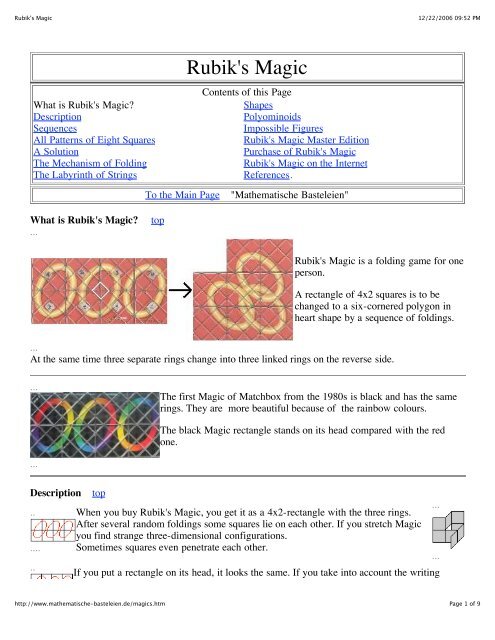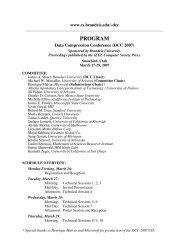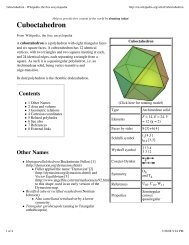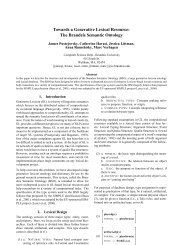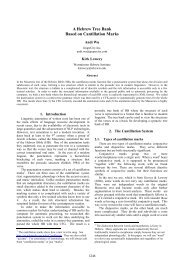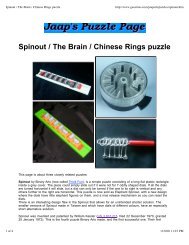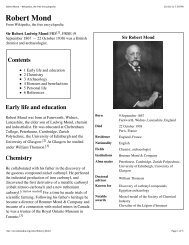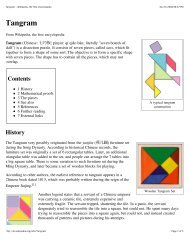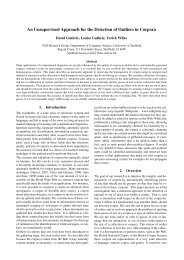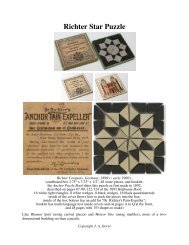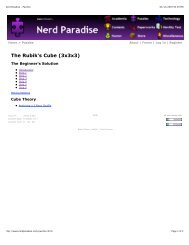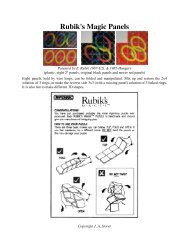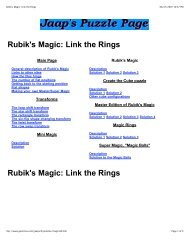Create successful ePaper yourself
Turn your PDF publications into a flip-book with our unique Google optimized e-Paper software.
<strong>Rubik's</strong> <strong>Magic</strong><br />
What is <strong>Rubik's</strong> <strong>Magic</strong>?<br />
Description<br />
Sequences<br />
All Patterns of Eight Squares<br />
A Solution<br />
The Mechanism of Folding<br />
The Labyrinth of Strings<br />
What is <strong>Rubik's</strong> <strong>Magic</strong>? top<br />
...<br />
http://www.mathematische-basteleien.de/magics.htm<br />
<strong>Rubik's</strong> <strong>Magic</strong><br />
Contents of this Page<br />
Shapes<br />
Polyominoids<br />
Impossible Figures<br />
<strong>Rubik's</strong> <strong>Magic</strong> Master Edition<br />
Purchase of <strong>Rubik's</strong> <strong>Magic</strong><br />
<strong>Rubik's</strong> <strong>Magic</strong> on the Internet<br />
References.<br />
To the Main Page "Mathematische Basteleien"<br />
...<br />
At the same time three separate rings change into three linked rings on the reverse side.<br />
...<br />
...<br />
Description top<br />
..<br />
....<br />
..<br />
12/22/2006 09:52 PM<br />
<strong>Rubik's</strong> <strong>Magic</strong> is a folding game for one<br />
person.<br />
A rectangle of 4x2 squares is to be<br />
changed to a six-cornered polygon in<br />
heart shape by a sequence of foldings.<br />
The first <strong>Magic</strong> of Matchbox from the 1980s is black and has the same<br />
rings. They are more beautiful because of the rainbow colours.<br />
The black <strong>Magic</strong> rectangle stands on its head compared with the red<br />
one.<br />
When you buy <strong>Rubik's</strong> <strong>Magic</strong>, you get it as a 4x2-rectangle with the three rings.<br />
After several random foldings some squares lie on each other. If you stretch <strong>Magic</strong><br />
you find strange three-dimensional configurations.<br />
Sometimes squares even penetrate each other.<br />
If you put a rectangle on its head, it looks the same. If you take into account the writing<br />
...<br />
...<br />
Page 1 of 9
<strong>Rubik's</strong> <strong>Magic</strong><br />
....<br />
http://www.mathematische-basteleien.de/magics.htm<br />
12/22/2006 09:52 PM<br />
"<strong>Rubik's</strong> <strong>Magic</strong>", you can say: <strong>Magic</strong> stands upright, if the words stand upright. The black<br />
<strong>Magic</strong> stands upright, if the words stand upside down.<br />
The reverse side of <strong>Magic</strong> has disordered squares.<br />
There is one unique square: It has three arcs. Here it is marked<br />
...<br />
yellow.<br />
...<br />
If you have solved <strong>Magic</strong>, this square goes into the centre.<br />
If you play with <strong>Magic</strong> and you want to control your movings, you can look at the three-arcs-square<br />
(Book 3).<br />
I prefer numbering the squares (Similar to book 2).<br />
...<br />
...<br />
The centre diamond<br />
...<br />
...<br />
I suggest numbering the squares as shown at the drawing on the left.<br />
Then there is a ring with eight squares, where the numbers stand<br />
upright.<br />
This is important to understand the following sequences:<br />
The 4x2-rectangle has a diamond formed by groves on four squares on both<br />
sides.<br />
If there are strings in it, it is drawn as shown on the right.<br />
Sequences top<br />
If you have mixed the <strong>Magic</strong> up, you must try to find any 4x2 rectangle.<br />
If you succeeded, you should try the following sequences.<br />
Ring<br />
Changing the rows (Sequence A)<br />
...<br />
...<br />
You quickly find out: You can open each<br />
rectangle to a ring.<br />
This sequence has the effect that two lines interchange. The writing "<strong>Rubik's</strong> <strong>Magic</strong>" stands<br />
horizontally as before.<br />
If you repeat the sequences you return to the start pattern. The sequence has the order 2. - The moves<br />
are reversible.<br />
Turning the squares (Sequence B)<br />
...<br />
...<br />
Page 2 of 9
<strong>Rubik's</strong> <strong>Magic</strong><br />
12/22/2006 09:52 PM<br />
The squares are ordered in another way at the same time. The writing "<strong>Rubik's</strong> <strong>Magic</strong>" stands<br />
horizontally before and vertically after making the moves.<br />
If you repeat the sequences you return to the start pattern. The sequence has the order 2. - The moves<br />
are reversible.<br />
Transformation<br />
By the way: The right 2x2 square doesn't move during this procedure.<br />
All Patterns of Eight Squares top<br />
...<br />
...<br />
There are 16 patterns of the 4x2 rectangle.<br />
http://www.mathematische-basteleien.de/magics.htm<br />
... ...<br />
How many patterns can you make with the<br />
squares?<br />
First observation: The sequence of the squares 1<br />
to 8 is kept at every pattern.<br />
There are four main patterns (left row), which<br />
turn into each other by the given sequences A<br />
and BAB.<br />
You can find three more to every main pattern<br />
by using the main squares and the sequences<br />
below.<br />
If you perform B at any 4x2 rectangle, you get different 2x4 rectangles.<br />
Page 3 of 9
<strong>Rubik's</strong> <strong>Magic</strong><br />
... ...<br />
Result: There are 32 patterns of 8 squares altogether.<br />
A Solution top<br />
First Step<br />
Second Step<br />
Transformation<br />
Eine kürzere Lösung<br />
...<br />
http://www.mathematische-basteleien.de/magics.htm<br />
Thus there must also be 16 rectangles of this kind.<br />
Change the basic rectangle to a rectangle with 1 in the right corner at the<br />
second row.<br />
Turn the rectangle as shown on the left. Use the tansformation.<br />
...<br />
The Mechanism of Folding top<br />
12/22/2006 09:52 PM<br />
Use a "mirror" version of the transformation for the heart shaped form.<br />
You get the rectangle with the three rings by the sequences B and C1.<br />
The reverse path is a solution.<br />
The first impression is that every piece has two hinges like the Jacob's<br />
ladder toy. This is partly right. The mechanism is more complicated<br />
however.<br />
If you lay two squares on top of each other, then a new hinge appears at<br />
the right angle to the old hinge.<br />
...<br />
...<br />
Page 4 of 9
<strong>Rubik's</strong> <strong>Magic</strong><br />
Where the hinge is depends on folding up or down. In the drawing strings are on the top in front.<br />
http://www.mathematische-basteleien.de/magics.htm<br />
12/22/2006 09:52 PM<br />
The Labyrinth of Strings top<br />
...<br />
Two adjacent squares are connected with strings, actually by two rings of fishing line. You<br />
see them running in grooves partly in front or behind the squares. If you lay two squares<br />
on top of each other, then strings jump into empty grooves of the opposite square.<br />
...<br />
The following description refers to the ring with the ordered squares.<br />
The eight squares are connected by 2x8 strings.<br />
One pair of rings goes through three squares.<br />
... ...<br />
There are four strings in the grooves of squares 1,3,5, and 7, and there are two strings in the grooves of<br />
the squares 2,4,6, and 8. The squares are not of the same kind. If a string gets snarled up in one place<br />
(it can happen!), you can cut one string in a groove, which has two strings, and remove it. You can fold<br />
<strong>Magic</strong> in spite of that, in fact it is even better. But don't cut the strings without having to do so. Better<br />
safe than sorry.<br />
Shapes top<br />
Double square-figures<br />
...<br />
...<br />
There are also the plane shapes on the left, which<br />
you can form with 4+4 squares. The T-form is<br />
missing.<br />
If you stretch these shapes you find different 3D<br />
configurations. "L" especially is productive.<br />
Though the sequence 1 to 8 is kept, strange shapes will develop, because the squares penetrate (also<br />
several times) each other.<br />
Cube<br />
Folding the cube is a special challenge.<br />
1 Start with the heart-like shape. Fold at the red<br />
...<br />
lines.<br />
2 Spread out the figure uand turn it at the same<br />
time. Watch at valleys and mountains.The two<br />
squares above stay above. The three right squares<br />
turn in direction of the arrows.<br />
Page 5 of 9
<strong>Rubik's</strong> <strong>Magic</strong><br />
..<br />
Be careful!.<br />
... ...<br />
http://www.mathematische-basteleien.de/magics.htm<br />
3 A cube arises.<br />
4 You can lift the square at the top and you get a<br />
basket.<br />
The cube is nicer, if it stands on two squares.<br />
The dark blue lines give the position of the hinges.<br />
But the way to figure 1 is long... (Book 3)<br />
12/22/2006 09:52 PM<br />
Symmetric Cubic Shapes<br />
There are many shapes, which you can find by accident. I restrict myself to symmetrical shapes, the<br />
squares of which are perpendicular to each other and which have no double walls because of their<br />
multitude and their "beauty".<br />
I ordered the shapes from two points of view:<br />
(1) The colour indicates the smallest rectangular solid (on the left) you can lay round the shape<br />
("wrapping solid").<br />
(2) The number below the shape is the number of the squares the solid and the shape have in common.<br />
Did I find all shapes?<br />
Polyominoids top<br />
You call figures of connected squares lying in cubic lattices polyominoids .<br />
Jorge L. Mireles Jasso worked on these figures. He offers a program on the internet, which can find,<br />
show and count polyominoids (URL see below). I used this program for figures with eight squares<br />
because of <strong>Magic</strong>. You get the large number of 207265 figures, which are ordered by the form of the<br />
wrapping rectangular solid.<br />
You can find much fewer shapes with <strong>Magic</strong>. There is a considerable reduction. You can explain that<br />
Page 6 of 9
<strong>Rubik's</strong> <strong>Magic</strong><br />
by square 3, which is in place of one of the eight squares.<br />
1st reduction:<br />
Each square has exactly two neighbour squares.<br />
This means the sequence of the squares is kept.<br />
2nd reduction:<br />
...<br />
...<br />
...<br />
Theoretically there are 16 possibilities for laying square number 4 to square number 3. If you turn<br />
number 4, you even get 32 cases.<br />
Impossible Figures top<br />
...<br />
...<br />
http://www.mathematische-basteleien.de/magics.htm<br />
In <strong>Magic</strong> there are only four places for a neighbour square. Square 4<br />
"rolls" around square 3.<br />
12/22/2006 09:52 PM<br />
It is easy to understand that this figure can't be solved with <strong>Magic</strong>. There is no chain. Square<br />
3 has no neighbour.<br />
The next case is difficult to investigate.<br />
The eight squares form a chain and you can imagine that three squares could be connected<br />
by strings.<br />
...<br />
...<br />
In spite of that there is no solution.<br />
James G. Nourse has found a rule for possible or impossible figures [(3) page 18f.].<br />
You must distinguish between squares with four and two strings.<br />
... ...<br />
Rule:<br />
Go around the figure in a closed line. Start at a square and go back to it. Calculate a sum step by step.<br />
Start with nought.<br />
>If you leave a square having four strings and go to the right, add 1. If you go to the left, subtract 1.<br />
>If you leave a square having two strings and go to the right, subtract 1. If you go to the left, add 1.<br />
>If you go straight, the sum doesn't change.<br />
If the sum is 0 in the end, the figure is possible with the 4x2-<strong>Magic</strong>.<br />
... ...<br />
Here the sum is 4 (-4 respectively)<br />
...<br />
Page 7 of 9
<strong>Rubik's</strong> <strong>Magic</strong><br />
<strong>Rubik's</strong> <strong>Magic</strong> Master Edition top<br />
.<br />
http://www.mathematische-basteleien.de/magics.htm<br />
..<br />
12/22/2006 09:52 PM<br />
There is a version of <strong>Magic</strong> with 12 squares in<br />
black or grey. You can transfer moves, but there<br />
are also new ones. The figures are more<br />
complicated.<br />
You can find a solution of the problem on the left<br />
in Christian Eggermont's Homepage. He has the<br />
black <strong>Magic</strong>. You must turn the grey <strong>Magic</strong> at the<br />
beginning, so that the writing is upside down.<br />
Purchase of <strong>Rubik's</strong> <strong>Magic</strong> top<br />
In Germany you can buy <strong>Rubik's</strong> <strong>Magic</strong> in every good toy shop.<br />
You pay 19.95 DM (1999).<br />
Copyright Jumbo International, Amsterdam. "<strong>Rubik's</strong> Cube is a trademark of Seven Towns Ltd. used<br />
under licence".<br />
<strong>Rubik's</strong> <strong>Magic</strong> on the Internet top<br />
German:<br />
Ronald Bieber<br />
Lösung<br />
English:<br />
Christian Eggermont<br />
<strong>Rubik's</strong> <strong>Magic</strong> (photos of figures, Solution to <strong>Rubik's</strong> <strong>Magic</strong> Master Edition)<br />
Courtney McFarren (Mathematica)<br />
<strong>Rubik's</strong> <strong>Magic</strong> I (@ Introduction @ Solving the Unlinked Side @ Solving the Linked Side @ Other<br />
Solutions)<br />
<strong>Rubik's</strong> <strong>Magic</strong> II (@ Introduction @ Solving the Linked Side @ Solving the Unlinked Side @ Other<br />
Solutions)<br />
Jaap Scherphuis<br />
<strong>Rubik's</strong> <strong>Magic</strong> (<strong>Rubik's</strong> <strong>Magic</strong>, Links to other useful pages, Create the Cube puzzle, Master Edition of<br />
<strong>Rubik's</strong> <strong>Magic</strong>, Super <strong>Magic</strong>, "<strong>Magic</strong> Balls", Making your own Master/Super <strong>Magic</strong>)<br />
Jorge L. Mireles Jasso<br />
The Minoids Applet (Run it!, Instructions, Java Sources, Screenshots, Sample Report, Polyominoids)<br />
Maarten Vermaak<br />
Folding Puzzles<br />
Page 8 of 9
<strong>Rubik's</strong> <strong>Magic</strong><br />
NN<br />
<strong>Rubik's</strong> <strong>Magic</strong> (The moves, The Solution to <strong>Rubik's</strong> <strong>Magic</strong>, Try to make these figures with <strong>Rubik's</strong><br />
<strong>Magic</strong>)<br />
Rubik on-line (Ernö <strong>Rubik's</strong> Official Homepage)<br />
The Amazing Folding Puzzle, Meet RUBIK'S <strong>Magic</strong>, Basic <strong>Magic</strong><br />
Wikipedia<br />
<strong>Rubik's</strong> <strong>Magic</strong><br />
Spanish:<br />
Javier Santos<br />
<strong>Rubik's</strong> <strong>Magic</strong> (Descripción, Objetivo de la Página, Conceptos Básicos, Algoritmo, Operadores)<br />
References top<br />
(1) Christoph Bandelow: <strong>Rubik's</strong> magische Ringe, Niedernhausen/Ts. 1986<br />
(2) Ashwin Belur, Blair Whitaker: <strong>Rubik's</strong> <strong>Magic</strong>, München 1986<br />
(3) James G. Nourse: Simple Solutions to <strong>Rubik's</strong> <strong>Magic</strong>, New York 1986<br />
top<br />
http://www.mathematische-basteleien.de/magics.htm<br />
Feedback: Email address on my main page<br />
This page is also available in German.<br />
URL of my Homepage:<br />
http://www.mathematische-basteleien.de/<br />
© 2000 Jürgen Köller<br />
12/22/2006 09:52 PM<br />
Page 9 of 9


